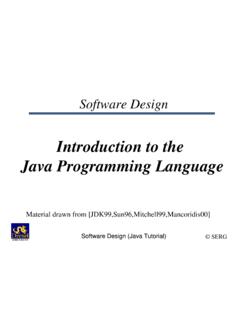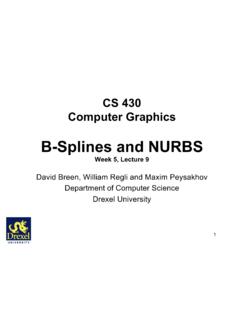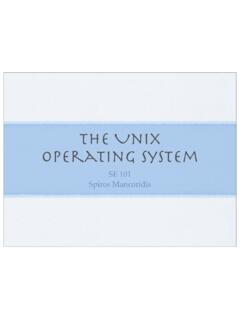Transcription of An Inside Look at MS-DOS - Drexel CCI
1 An Inside look at MS-DOSAn Inside look at MS-DOS The design decisions behind the popular operating systemTim PatersonSeattle Computer Products1114 Industry , WA 98188 The purpose of a personal computer operating system is to provide the user with basic control of the machine. A less obvious function is to furnish the user with a high-level, machine-independent interface for application programs, so that those programs can run on two dissimilar machines, despite the differences in their peripheral hardware. Having designed an 8086 microprocessor card for the S-100 bus and not finding an appropriate disk operating system on the market, Seattle Computer Products set about designing MS-DOS .
2 Today MS-DOS is the most widely used disk operating system for personal computers based on Intel's 8086 and 8088 Design CriteriaThe primary design requirement of MS-DOS was CP/M-80 translation compatibility, meaning that, if an 8080 or Z80 program for CP/M were translated for the 8086 according to Intel's published rules, that program would execute properly under MS-DOS . Making CP/M-80 translation compatibility a requirement served to promote rapid development of 8086 software, which, naturally, Seattle Computer was interested in. There was partial success: those software developers who chose to translate their CP/M-80 programs found that they did indeed run under MS-DOS , often on the first try.
3 Unfortunately, many of the software developers Seattle Computer talked to in the earlier days preferred to simply ignore MS-DOS . Until the IBM Personal Computer was announced, these developers felt that CP/M-86 would be the operating system of 8086/8088 concerns crucial to the design of MS-DOS were speed and efficiency. Efficiency primarily means making as much disk space as possible available for storing data by minimizing waste and overhead. The problem of speed was attacked three ways: by minimizing the number of disk transfers, making the needed disk transfers happen as quickly as possible, and reducing the DOS's "compute time," considered overhead by an application program.
4 The entire file structure and disk interface were developed for the greatest speed and (1 of 14)10/5/2006 9:42:19 AMAn Inside look at MS-DOSThe last design requirement was that MS-DOS be written in assembly language. While this characteristic does help meet the need for speed and efficiency, the reason for including it is much more basic. The only 8086 software-development tools available to Seattle Computer at that time were an assembler that ran on the Z80 under CP/M and a monitor/debugger that fit into a 2K-byte EPROM (erasable programmable read-only memory). Both of these tools had been developed in OrganizationThe core of MS-DOS is a device-independent input/output (I/O) handler, represented on a system disk by the hidden file It accepts requests from application programs to do high-level I/O, such as sequential or random access of named disk files, or communication with character devices such as the console.
5 The handler processes these requests and converts them to a very low level form that can be handled by the I/O system. Because is hardware independent, it is nearly identical in all MS-DOS versions provided by manufacturers with their equipment. Its relative location in memory is shown in figure 1. Figure 1: Map of memory areas as assigned by MS-DOS . The I/O system is totally device dependent and is represented on the disk by the hidden file It is normally written by hardware manufacturers (who know their equipment best, anyway) with the notable (2 of 14)10/5/2006 9:42:19 AMAn Inside look at MS-DOSexception of IBM, whose I/O system was written to IBM's specifications by Microsoft.
6 The tasks required of the I/O system, such as outputting a single byte to a character device or reading a contiguous group of physical disk sectors into memory, are as simple as command processor furnishes the standard interface between the user and MS-DOS and is contained in the visible file The processor's purpose is to accept commands from the console, figure out what they mean, and execute the correct sequence of functions to get the job done. It is really just an ordinary application program that does its work using only the standard MS-DOS function requests. In fact, it can be replaced by any other program that provides the needed user are, however, two special features of the COMMAND file.
7 First, it sets up all basic error trapping for either hard-disk errors or the Control-C abort command. provides no default error handling but simply traps through a vector that must have been previously set. Setting the trap vector and providing a suitable error response is up to COMMAND (or whatever program might be used to replace it).The second special feature is that COMMAND splits itself into two pieces, called the resident and transient sections. The resident, which sits just above MS-DOS in low memory, is the essential code and includes error trapping, batch-file processing, and reloading of the transient.
8 The transient interprets user commands; it resides at the high end of memory where it can be overlaid with any applications program (some of which need as much memory as they can get). This feature is of limited value in systems with large main memory, and it need not be imitated by programs used as a replacement for provides both a useful set of built-in commands and the ability to execute program files located on the disk. Any file ending with the extensions .COM, .EXE, or .BAT can be executed by COMMAND simply by typing the first part of the file name (without extension). You can normally enter parameters for these programs on the command line, as with any of the built-in commands.
9 Overall, the effect is to give you a command set that can be extended almost without limit just by adding the command as a program file on the disk. The three different extensions allowed on program files represent different internal file .COM files are pure binary programs that will run in any 8086 memory segment; in order for this to be possible, the program and data would ordinarily have to be entirely in one 64K-byte segment. l .EXE files include a header with relocation information so that the program may use any number of segments; all intersegment references are adjusted at load time to account for the actual load segment.
10 L .BAT (batch) files are text files with commands to be executed in sequence by COMMAND. File (3 of 14)10/5/2006 9:42:19 AMAn Inside look at MS-DOSD isks are always divided up into tracks and sectors, as shown in figure 2. To access any particular block of data, the program first moves to the correct track, then has you wait while the spinning disk moves the correct sector under the head. Figure 2: Placement of disk sectors in IBM Personal Computer (single-sided) format. A somewhat more abstract view of disks was taken in developing MS-DOS . MS-DOS views the disk, not in terms of tracks and sectors, but as a continuous array of n logical sectors, numbered from 0 to n - 1.


















